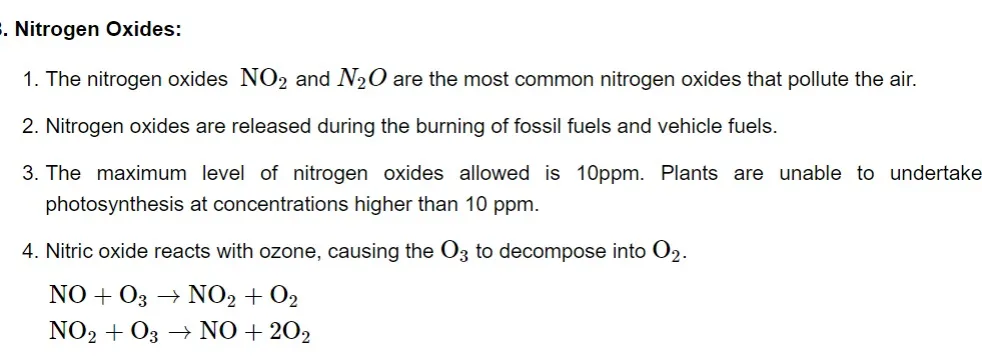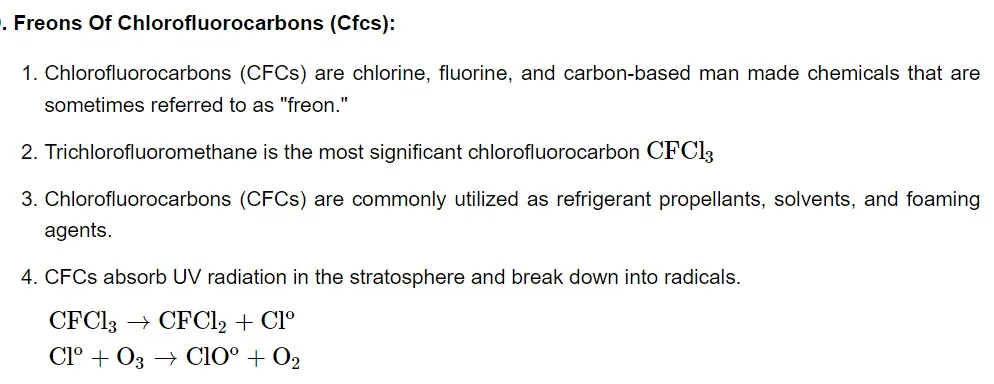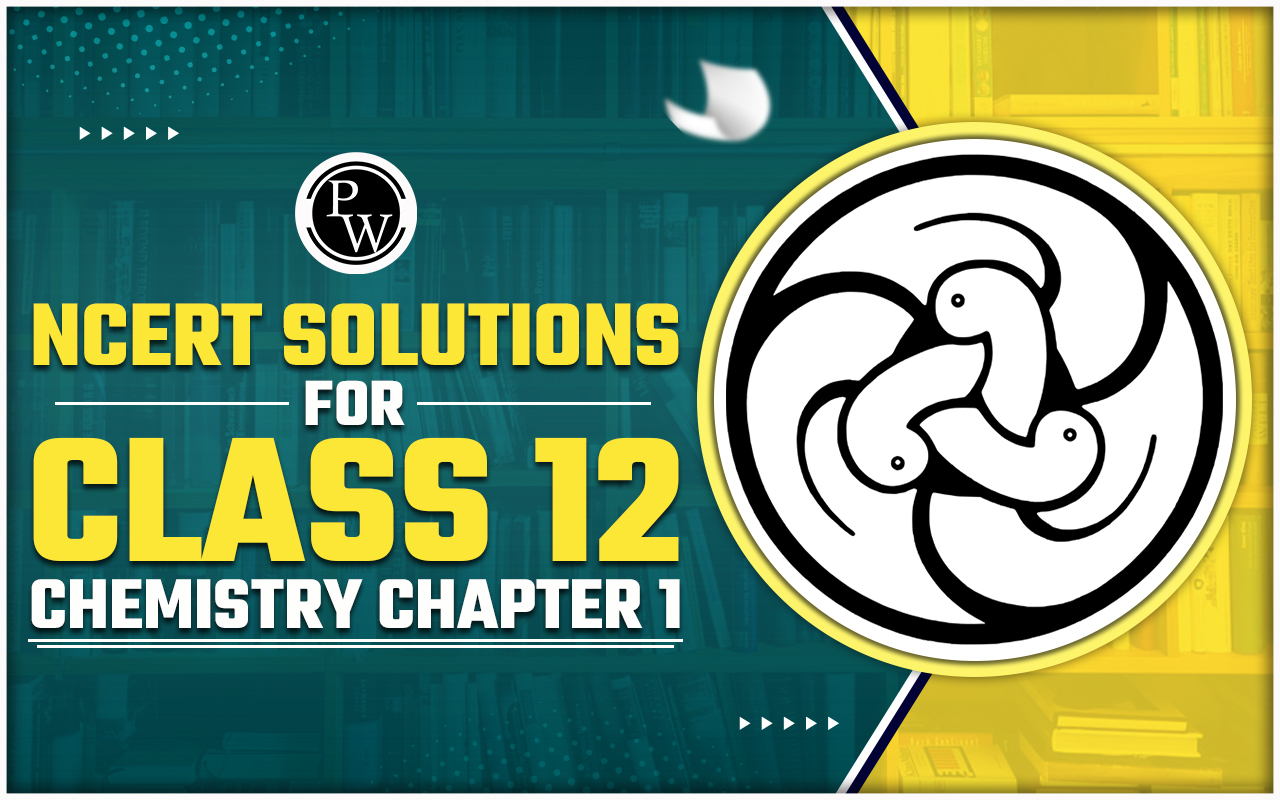
CBSE Class 11 Chemistry Notes Chapter 14: Since it approaches environmental issues from a chemical perspective, Environmental Chemistry, often known as Environmental Science, is a crucial chapter for students in class 11. The study of reactions, origins, consequences, and essentially the fate of species in the environment are also covered in this chapter. Additionally, because the subjects covered are so broad, it's possible that students won't retain every detail, which could reduce their output. Taking note of this, our professionals have produced the CBSE Class 11 Chemistry Notes Chapter 14.
CBSE Class 11 Chemistry Notes Chapter 14 Overview
Analysing the chemistry of the environment is important. All living things are negatively impacted by unwanted environmental changes, including people, plants, and animals. All three states of matter contain atmospheric contaminants. There are various approaches to studying tropospheric and stratospheric pollution in the atmosphere.- The troposphere is the lowest part of the atmosphere. Here, there are organisms like humans, animals, plants, etc. Oxides of carbon, sulphur, halogens, nitrogen, and other elements are the source of this pollution.
- The stratosphere is the stratum that is 50 km above sea level and above the troposphere. Ozone is one of the key components of this layer.
CBSE Class 11 Chemistry Notes Chapter 14 PDF
Environmental science offers strong and reliable information on every subject. The material provided is quite pertinent and concise, and these notes will be a valuable resource for comprehending the chapter in its entirety. Additionally, students can study more effectively and do better on tests. Here CBSE Class 11 Chemistry Notes Chapter 14 PDF is provided for the students.CBSE Class 11 Chemistry Notes Chapter 14 PDF
CBSE Class 11 Chemistry Notes Chapter 14
The air, water, soil, vegetation, and atmosphere in which we exist are all included in the environment. The branch of chemistry known as "environmental chemistry" studies how living things interact with their environment.Pollution Effects
The London Smog claimed the lives of over 3,000–4,00000 people. "Minamata," a disease caused by mercury pollution in the waters of Minamata Island that spread after people ate fish caught there, has sickened a large number of people in Japan. Methyl isocyanate (MIC) gas leaked from a union carbide plant in Bhopal in 1984, killing thousands of people. Numerous buildings in Italy, especially in Rome, are being destroyed by acid rain. A "dead sea," the Mediterranean Sea can no longer sustain any kind of aquatic life. A special board has cleansed India's revered Ganges river. Air pollution is caused by dangerous radiation released by nuclear weapons testing and radioactive fallout from reactors. The Taj Mahal's splendor is diminishing because of air pollution. Thousands of people perished in World War II as a result of the atomic bomb in the Japanese cities of Hiroshima and Nagasaki. The effects of radioactive pollution were more severe for the people living in Chernobyl, Russia. an incident at the Visakhapatnam oil refinery owned by HPCL. An accidental forest fire in Indonesia caused significant environmental harm.Definition of Term
Pollutant
Any natural material that has increased in quantity due to human activity and hurts the environment is considered a pollutant. Lead in mercury, sulfur dioxide, carbon dioxide, and so forth are a few examples.Contaminant
A substance that is not present in nature but is released into the environment as a result of human activity is called a contamination. For instance, in Bhopal, the Union Carbide factory leaked the deadly chemical methyl isocyanate (MIC).Receptor
A receptor is a medium that is affected by pollutants.Sink
A washbasin is a material that interacts with the pollutant to lessen its effects. microbes that digested dead animals or converted trash and dry leaves into fertilizer. One significant carbon dioxide sink is seawater. Additionally, plants are great CO2 sinks. Speciation is the process of grouping different pollutants based on how harmful they are. Alkylated mercury is more dangerous than pure mercury. Compared to lead, mercury compounds are hazardous.Oxygen Dissolved (D.O.)
The amount of oxygen in water that has dissolved is known as dissolved oxygen, or D.O. Four to six milligrammes of oxygen per litre of water is needed for the healthy growth of plants and animals. Water in waterfalls is deemed polluted when the D.O. value goes below 5 parts per million. Water contamination decreases with increasing DO values and vice versa. The D.O. value decreases with increasing temperature.B.O.D. (Biochemical Oxygen Demand)
Biochemical oxygen demand (BOD) is the quantity of oxygen needed by bacteria and other microorganisms to break down organic matter at a given temperature in aerobic (oxygen-present) conditions. For pure water, the B.O.D. value is 3 ppm. The B.O.D. value of impure water is higher than that of pure water (>3 ppm). Municipal sewage has a BOD value ranging from 100 to 4000 ppm. Fish, plants, and other aquatic species perish in water with higher BOD levels.COD (Chemical Oxygen Demand)
An approximate measure of the amount of oxygen that can be used by processes in a particular solution is the chemical oxygen demand, or COD. Typically, it is shown as the mass of oxygen used divided by the solution's volume. One crucial factor in assessing the quality of water is the COD value. Potassium dichromate that has been acidified to fifty percent can yield the aforementioned O2. The level of pollution in the environment increases with the COD levels.COD or BOD Value Determination
Parts per million, or ppm, are used to measure BOD or COD. It is the quantity of oxygen parts per million needed to create one million parts of water per million. or it's the number of oxygen milligrammes required per liter of water.TLV (Threshold Limit Value)
The threshold limit value (TLV) is the lowest concentration of dangerous substances or pollutants in the atmosphere that might cause harm to an individual if they are exposed to them for eight hours a day at work. The maximum permitted level of pollutants in areas used for mining and industry is known as TLV.Environment Segments
There are four segments to the environment.
a) Atmosphere b) Hydrosphere c) Lithosphere d) Biosphere
Atmosphere
The layer of air that envelops the planet is called the atmosphere. The earth is shielded by the atmosphere. It transmits visible, near-infrared, and near-ultraviolet radiation while absorbing some of the sun's electromagnetic radiation.Hydrosphere
The portion of water that is present on Earth is known as the hydrosphere. Four-fifths of the earth is covered in water. 97% of the water in the hydrosphere is ocean, 3% is ice found in the polar ice caps, and the remaining water is used for agriculture and drinking. Despite not being fit for human consumption, seawater is home to a wide variety of marine life and plants.Lithosphere
Except the hydrosphere, land makes up the remaining space on Earth. We refer to it as the Lithosphere. The lithosphere is home to humans, animals, and plants, whereas the inner layers of the earth's surface are home to minerals.Biosphere
All living things, including humans, animals, and plants, make up the biosphere. There are connections between the biosphere and other environmental elements. All biological systems interact with their surroundings; this is referred to as an "ecosystem". The ecosystem's other components are interconnected with the biosphere.


Depletion in the Ozone Layer
The O3 layer has holes in it close to the earth's north and south poles as a result of CFCs. A 3% increase in the amount of UV radiation hitting the earth is caused by ozone layer depletion. UV radiation has an effect on how plants photosynthesize.Global Warming or The Greenhouse Effect
Water vapour and carbon dioxide absorb infrared light that reaches the ground and reflect some of it back onto the earth's surface. This causes the surface of the earth to warm. The warming of the earth's surface is known as the greenhouse effect. Deforestation is contributing to an increase in the amount of CO2 in the atmosphere. In the troposphere, ozone causes harm, while in the stratosphere, it serves as a protective layer. By planting trees and forests, more sinks must be produced in order to counteract global warming. The atmospheric concentration of carbon dioxide is 0.03 percent. One of the gases responsible for the greenhouse effect is CO2 (19%), followed by CH4 (carbon monoxide) (50%). The remaining gases are water vapour (2%), nitrogen oxide (4%), oxygen (8%), and chlorofluorocarbons (4%). Organic pollutants include waste from industries and farms. Examples of organic pollutants include plastics, fibres, paints, peroxides, dyes, weedicides, insecticides, and plasma chemicals. Industrial waste is produced by the pulp, paper, leather, and sugar sectors.Food Chain: The term "food chain" refers to the movement of pollutants from one location to another. There are fish, birds, plants, animals, and people among them.
Bioamplification: When we move from lower to higher animals, the concentrations of pollutants rise. This phenomenon is known as bio-amplification.
Our Responsibility to the Environment
Microorganisms and enzymes can breakdown a wide range of waste substances, including polymers. Any reaction's byproducts are pollutants. Therefore, processes that result in an environmentally favorable response with no byproducts should be developed. It is necessary to use non-conventional fuels and energy systems in place of conventional fuels and energy systems. Technology that is ecologically benign and clean needs to be created and used. The growing population needs to be controlled.i) A change in color and a rise in salinity are signs of polluted water.
ii) foul odor
iii) excessive weed growth
iv) A decrease in fish growth.
Contaminated water causes diseases like cholera, typhoid, jaundice, and diarrhea.
Benefits of CBSE Class 11 Chemistry Notes Chapter 14
Relevant to the most recent exam formats and syllabus: Students can concentrate on the most pertinent subjects and formats that they are likely to encounter in their Class 11 Chemistry exams by using our fundamental subjective questions and notes, which are made to match the most recent curriculum and exam patterns.
In-depth and simple to comprehend Answers: We offer thorough explanations, which facilitate students' understanding of difficult ideas and help them grow from their errors.
Finding Weak Areas: Students can pinpoint particular topics that need more work and attention by consulting our subjective questions and the notes from Class 11.
Enhancement of Problem-Solving Ability: Students can improve their analytical and critical thinking abilities by regularly practicing 1 and 2 mark questions with revision notes.
CBSE Class 11 Chemistry Notes Chapter 14 FAQs
Which is the easiest chapter in chemistry class 11?
Which is the most important chapter in chemistry class 11?
What is the name of Chapter 14 of chemistry Class 11?










